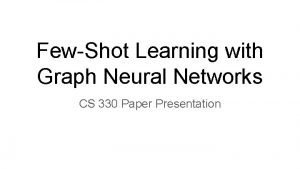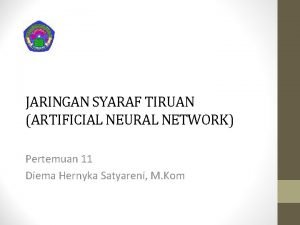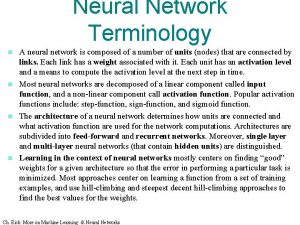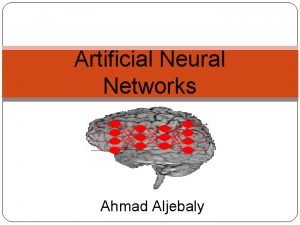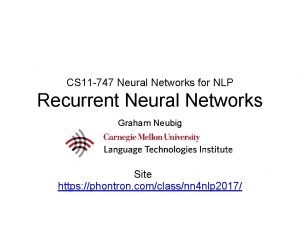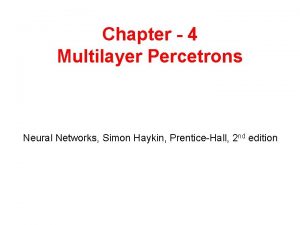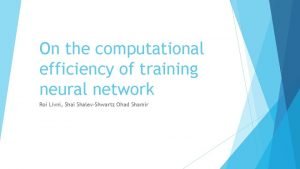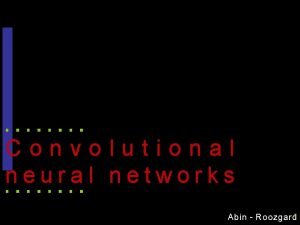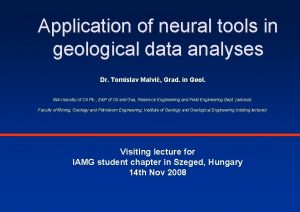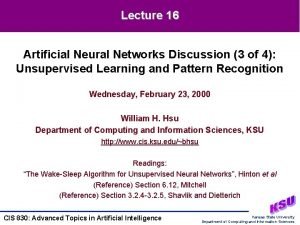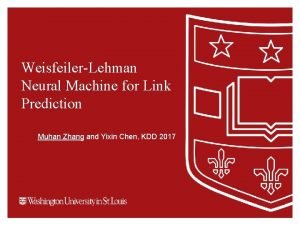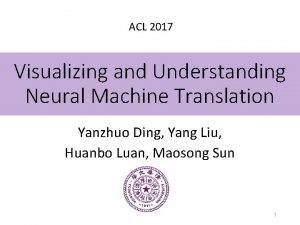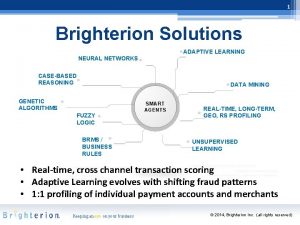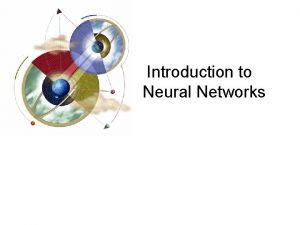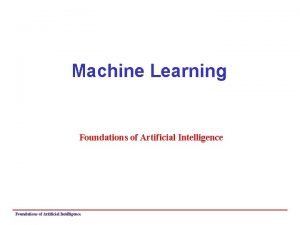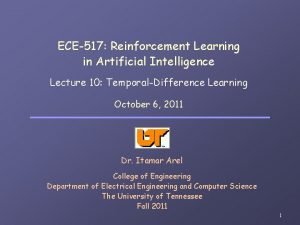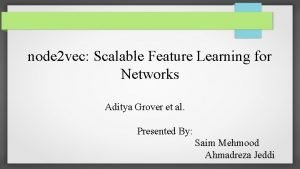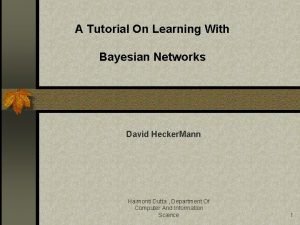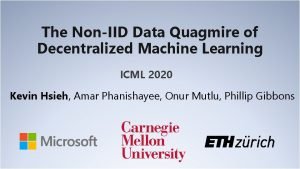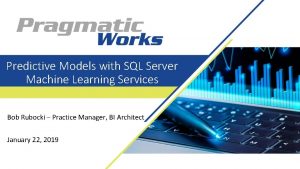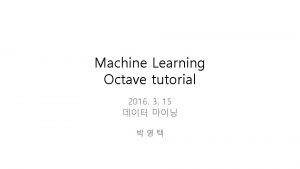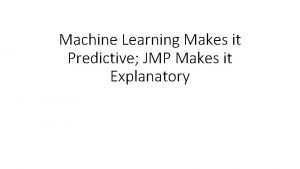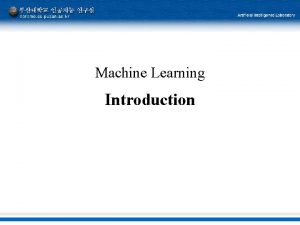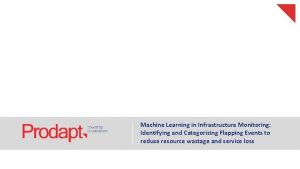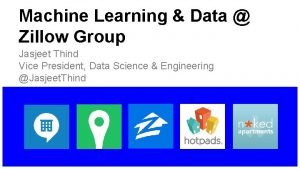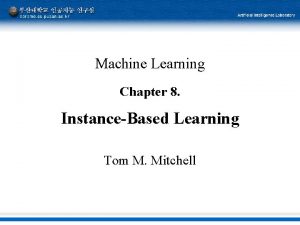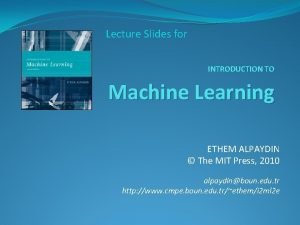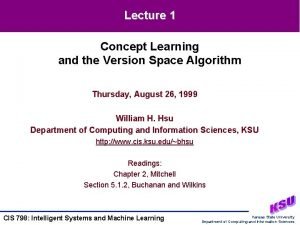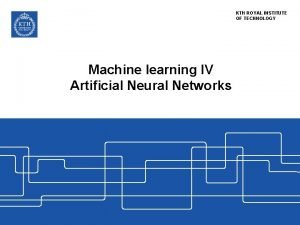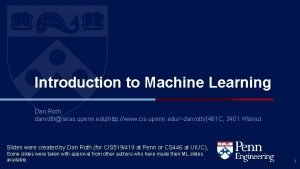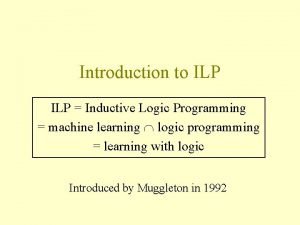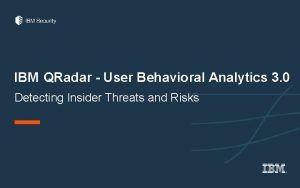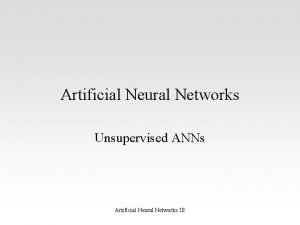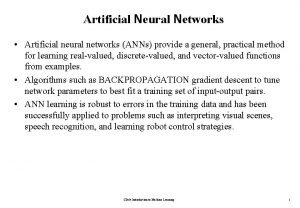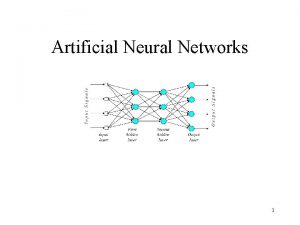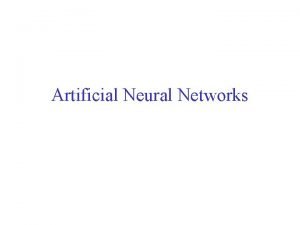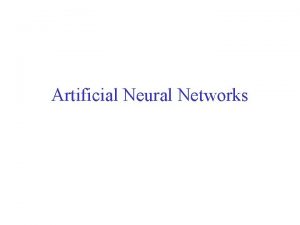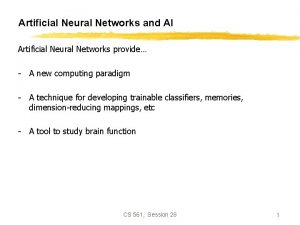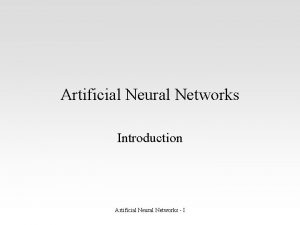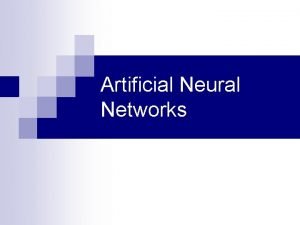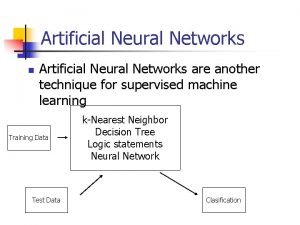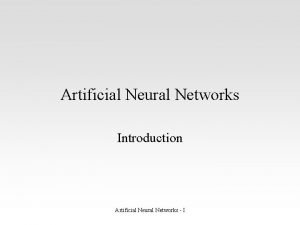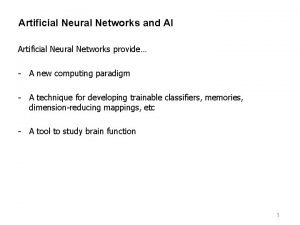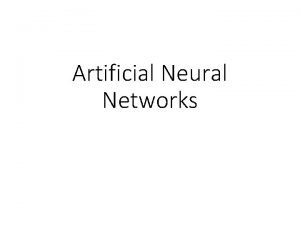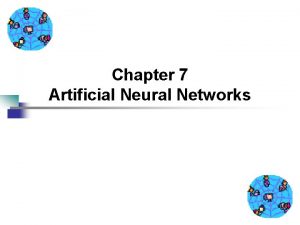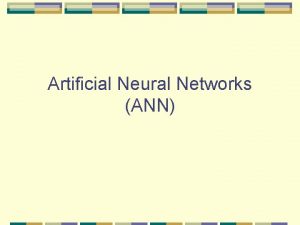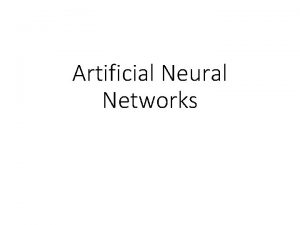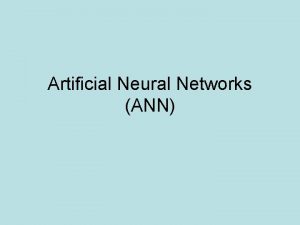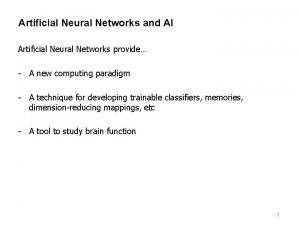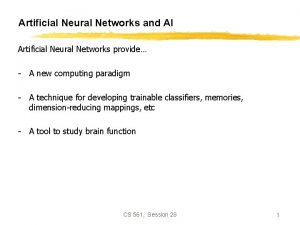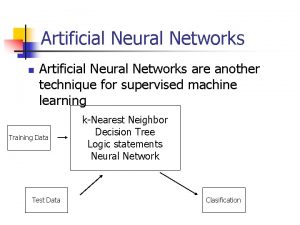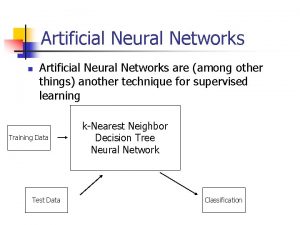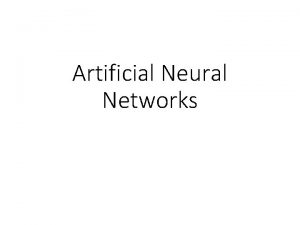Artificial Neural Networks ANNs Machine Learning Dr Lan















![Principles of ANN Associative Memory (AM) Principle [Longuett, Higgins, 1968] § Information vector (pattern, Principles of ANN Associative Memory (AM) Principle [Longuett, Higgins, 1968] § Information vector (pattern,](https://slidetodoc.com/presentation_image_h/ac1b8f8251ce5ef72f8c90b174f7436e/image-16.jpg)



















































![Signal Hierarchy • 29 signals to classify • SNR = [-20 18] d. B Signal Hierarchy • 29 signals to classify • SNR = [-20 18] d. B](https://slidetodoc.com/presentation_image_h/ac1b8f8251ce5ef72f8c90b174f7436e/image-68.jpg)












![References [1] Elements of Artificial Neural Networks, by Mehrotra, Mohan, and Ranka, MIT Press References [1] Elements of Artificial Neural Networks, by Mehrotra, Mohan, and Ranka, MIT Press](https://slidetodoc.com/presentation_image_h/ac1b8f8251ce5ef72f8c90b174f7436e/image-81.jpg)

- Slides: 82

Artificial Neural Networks (ANNs) & Machine Learning Dr. Lan Nguyen Dec 13, 2018 Presented to IEEE Com. Sig, Orange, CA

Introduction to Neural Networks Neural Network (NN) is part of the nervous systems, containing a large number of neurons (nerve cells) where network denotes connections between these cells, a graph-like structure Artificial Neural Networks (ANNs) refer to computing systems whose central theme is to borrowing from the biological neural networks § Also referred as “neural nets, ” “artificial neural systems, ” “parallel distributed processing, ” etc. 11/27/2020 2

Motivation Why Artificial Neural Networks (ANNs)? § Many tasks involving intelligence are extremely difficult to automate, but can be done easily (effortless) by animals e. g. recognize various objects and make sense out of large amount of visual information in their surrounding § Tasks involve approximate, similarity, common sense reasoning e. g. driving, playing piano, etc. § These tasks are often ill-defined, experience based, and hard to apply logic This necessitates the study of cognition i. e. the study and simulation of Neural Networks 11/27/2020 3

What is ANN? Conventional computers can do just about everything… ANN is a novel computer architecture and algorithm relative to conventional computers It allows very simple computational operations (additions, multiplications, and logic elements) to solve complex, ill-defined mathematical problems, non-linear, and stochastic problems A conventional algorithm will employ a set of complex equations and only will apply to that problem exactly to it ANN will be computationally and algorithmically simple and it will have self-organizing features to handle a wide range of problems. 11/27/2020 4

Biological Neural Activity Neural activities passes from one neuron to another neuron in terms of electrical from body down to axon by means of electro chemical process Axon acts as connection wire Each neuron has a body, an axon, and many dendrites § Neuron’s nucleus is where the neural computation takes place § Can be in 2 states: firing and rest § Neuron fires if incoming stimulus exceeds the threshold Synapse: Thin gap between axon of one neuron and dendrites of another one § Signal exchange 11/27/2020 5

Biological Neural Activity Synaptic Junction Interconnection of Biological Neural Nets 11/27/2020 6

Analog Representations dendrites . . Neural Cell Axon . . Outputs . . Schematic Analog of a Biological Neural Cell i . . Cell i+1 Schematic Analog of a Biological Neural Network 11/27/2020 7

Artificial vs Biological NN Artificial NN § Nodes Input Output Activation/Node function § Connections Connection strength Biological NN § Cell body Signal from other neurons Firing frequency Firing mechanism § Synapses Synaptic strength. Highly parallel, simple local computation at the neuron level, achieve global results as emerging property of the interaction at the network level Pattern directed (meaning of individual nodes only in the context of a pattern) Fault-tolerant/graceful degrading Learning/adaptation plays an important role 11/27/2020 8

Artificial vs Biological NN Characteristics ANN Biological NN Speed Fast Slow Processing Exhibit some degrees of sequential instructions Massive Parallel Size and Complexity Do not involve much computational neurons. Difficult to perform complex tasks Storage Fixed size. New information may overwrite old memory storage Information is stored in the strength of the interconnections without destroying old information Fault Tolerance Inherently not Exhibit fault tolerance. Info is distributed in the connections Control Mechanism There is a control limit to monitor all activities of computing No specific control mechanism external to the computing task 11/27/2020 9

Abridged History of ANN Mc. Culloch and Pitts (1943) § First mathematical model for biological neurons using simple binary functions. This model has been modified and widely applied in subsequent work Landahl, Mc. Culloch, and Pitts (1943) § All Boolean operations can be implemented by Mc. Culloch and Pitt model (with different threshold and excitatory/inhibitory connections) Hebb (1949) § Hebbian rule of learning: increase the connection strength between neurons i and j whenever both i and j are activated § Or increase the connection strength between nodes i and j whenever both nodes are simulated ON or OFF 11/27/2020 10

Abridged History of ANN Early booming (50’s to early 60’s) § Rosenblatt (1958) Perceptron: network of threshold nodes for pattern classification Perceptron learning rule Perceptron convergence theorem: Every thing that can be represented by a perceptron can be learned § Widrow and Hoff (1960, 1962) Learning rule based on gradient descent § Minsky’s attempt to build a general purpose machine with Pitts/Mc. Culloch units 11/27/2020 11

Abridged History of ANN The setback (mid 60’s to late 70’s) § Serious problems with perceptron model (Minsky’s book 1969) Single layer perceptrons cannot represent/learn a simple function such as XOR Multi-layer of non-linear units may have greater power but there is no learning rule for such nets Scaling problem: connection weights may grow infinitely The first two problems overcame in 80’s but the scaling problem remains § Death of Rosenblatt (1964) 11/27/2020 12

Abridged History of ANN Renewed enthusiasm and flourish (80’s to present) § New techniques Backpropagation learning for multi-layer feed forward nets (with non-linear, differentiable node functions) Thermodynamic models (Hopfield net, Boltzmann machine, etc. ) Unsupervised learning § Impressive applications: character recognition, speech recognition, text- to-speech transformation, process control, associative memory etc. § Traditional approaches face difficult challenges Caution: § Do not underestimate difficulties and limitations § Pose more challenges than solutions 11/27/2020 13

Principles and Model of ANN 14

Principles of ANN First formulated by Mc. Culloch and Pitts (1943) by 5 assumptions 1. 2. 3. 4. 5. Activity of a neuron (ANN) is all-or-nothing # excited synapses > 1 within a given interval for a neuron to be excited The only significant delay within the neural system is the synaptic delay Inhibitor synapse prevents the excitation of a neuron The structure of the interconnection does not change over time By assumption 1, the neuron is a binary element Hebbian rule (1949) 11/27/2020 15
![Principles of ANN Associative Memory AM Principle Longuett Higgins 1968 Information vector pattern Principles of ANN Associative Memory (AM) Principle [Longuett, Higgins, 1968] § Information vector (pattern,](https://slidetodoc.com/presentation_image_h/ac1b8f8251ce5ef72f8c90b174f7436e/image-16.jpg)
Principles of ANN Associative Memory (AM) Principle [Longuett, Higgins, 1968] § Information vector (pattern, code) that is input into a group of neurons may (over repeated application of such input vectors) modify the weights at the input of that certain neuron in an array of neurons to which it is input, such that they more closely approximate the coded input Winner Take All (WTA) Principle [Kohonen, 1984] § If an array of N neurons receiving the same input vector, then only 1 neuron will fire. This neuron being the one whose weight best fit the given input vector § This principle saves firing from a multiple of neurons when only one can do the job 11/27/2020 16

ANN Model 11/27/2020 17

Single Input ANN Model Single Input 11/27/2020 18

Multiple Inputs ANN Model Multiple Inputs 11/27/2020 19

Network Architectures 20

Multi-Layer Network Architectures Four major multi-layer network architectures: The Back-Propagation Network [Rumelhart et al, 1986] 1. A multi-layer Perceptron based ANN Provide an elegant solution to hidden layers learning The Hopfield Network [Hopfield, 1982] 2. Feedback between neurons Weight adjustment is based on Associate Memory The Counter Propagation Network [Hecht-Nielsen, 1987] 3. Self Organizing Mapping (SOM) is employed to facilitate unsupervised learning Winner Take All (WTA) principle The LAMSTAR (Large Memory Storage and Retrieval) Network 4. A Hebbian network that use SOM layer and WTA principle Other networks: Adaptive Resonance Theory (ART), Cognitron, Statistical Training, Recurrent Networks, etc. 11/27/2020 21

Multilayer Network Architecture 11/27/2020 22

Classes Acyclic Networks § Connections do not form directed cycles § Multi-layered feedforward nets are acyclic Recurrent Networks § Nets with directed cycles (feedback) § Much harder to analyze than acyclic nets § Long short-term memory (LSTM) Modular nets § Consist of several modules, each of which is itself a neural net for a particular sub-problem § Sparse connections between modules 11/27/2020 23

Recurrent Network Architecture 11/27/2020 24

Fully Connected Network Architecture Input Nodes: Receive inputs from environment Output Nodes: Send signals to environment Hidden Nodes: No direct interaction to the environment 11/27/2020 25

Layered Network Architecture Input from the environment are applied to input layer (layer 0) Nodes in input layer are place holders with no computation occurring, i. e. , their node functions are identity function 11/27/2020 26

Feedforward Network Architecture Conceptually, nodes at higher levels successively abstract features from preceding layers 11/27/2020 27

ANNs Learning and Training 28

Perceptron: A Learning neuron 11/27/2020 29

Linear Separability § A set of (2 D) patterns (x 1, x 2) of two classes is linearly separable if there exists a line on the (x 1, x 2) plane § A perceptron can be built with 11/27/2020 w 0 + w 1 x 1 + w 2 x 2 = 0 Separates all patterns of one class from the other class 3 input x 0 = 1, x 2 with weights w 0, w 1, w 2 30

Linear Separability 11/27/2020 31

Logical AND x 1 x 2 Output -1 -1 1 o o x o X: Class I : output 1 O: Class II: output -1 11/27/2020 32

Linear Inseparable 11/27/2020 33

Perceptron Learning Rule Any problem that can be represented by a perceptron can be learned by a learning rule Theorem: The perceptron rule will always converge to weights which accomplish the desired classification, assuming such weights exist 11/27/2020 34

Supervised Learning Network is provided with a set of examples of proper network behavior, i. e. , known inputs and targets {p 1, t 1}, {p 2, t 2}, …, {p. Q, t. Q} § p and t are inputs and corresponding correct (target) outputs 11/27/2020 35

Reinforcement Learning Similar to supervised learning § Network is only provided with a score instead of correct target outputs § Score is used to measure the performance over some sequence of inputs § Less common than supervised learning § More suitable in control systems 11/27/2020 36

Unsupervised Learning No target outputs are available Only network inputs are available to the learning algorithm § Weights and biases are updated in response to inputs Networks learn to categorize or cluster the inputs into a finite number of classes 11/27/2020 37

Hebb’s Postulate (1949) “When an axon of cell A is near enough to excite a cell B and repeatedly or persistently takes part in firing it, some growth process or metabolic change takes place in one or both cells such that A’s efficiency, as one of the cells firing B, is increased” 11/27/2020 38

Hebb Rule 11/27/2020 39

ADALINE 11/27/2020 40

Adaptive Linear Combiner (ALC) output error 11/27/2020 41

ADALINE Source: Adaptive Switching Circuit, by Widrow and Hoff, 1960 11/27/2020 42

ADALINE vs Perceptron ADALINE network is very similar to a perceptron They both suffer the same limitations: they can only solve linearly separable problems ADALINE employs LMS learning rule, which is more powerful than the perceptron learning rule § Perceptron learning rule is guaranteed to convergence that categorized to the training set. The resulting can be noise sensitive since patterns can lie closely to the decision boundaries § LMS minimizes mean square error, therefore tries to move away from the decision boundaries as far from the training set as possible 11/27/2020 43

Limitations The perceptron learning rule of Rosenblatt and the LMS algorithm of Widrow-Hoff were design to train a single layer perceptron-like networks § They are only to solve linearly separable classification problems § Both Rosenblatt and Widrow were aware of the limitations. Both proposed multilayer networks to overcome them. However, they were NOT able to generalize their algorithms to train these powerful networks 11/27/2020 44

The Back Propagation (BP) Algorithm The first description of the backpropagation (BP) algorithm was contained in thesis of Paul Werbos in 1974. However, the algorithm was presented in the context of general networks where neural networks as special case and was not disseminated in the neural networks community It was not until the mid 1980 s, the backpropagation was rediscovered and widely publicized The multilayer perceptron, trained by the backpropagation algorithm, is currently the most widely used neural network. 11/27/2020 45

The Back Propagation (BP) Algorithm The backpropagation is the generalization of the LMS algorithm Similar to the LMS learning, the backpropagation is an approximate steepest descent algorithm § The performance index is the mean squared error The difference between the LMS and the BP is only the way in which the derivatives are calculated 11/27/2020 46

Multilayer Perceptron Cascaded of perceptron networks § The output of the first network is the input of the second network, and the output of the second network is the input of the third network, etc. Each layer may have different number of neurons § Also may have different activation function § Same activation function in each layer 11/27/2020 47

Function Approximation We could use multilayer networks to approximate almost any functions § If we have sufficient number of neurons in the hidden layer It has been shown that [1] two layer networks, with sigmoid activation function in the hidden layer and a linear activation function in the output layer, we can approximate virtually any function of interest to any degree of accuracy, provided sufficiently many hidden neurons are available. [1] K. H. Hornik, et al, “Multilayer Feedforward Networks are Universal Approximators, ” Neural Networks, vol. 2, no. 5, pp 359366, 1989 11/27/2020 48

Machine Learning 49

What is Machine Learning? A model technique that involves data and figures out the model of data An inductive approach The model is the final product of machine learning It addresses the concept of data, model, and it has nothing to do with learning Learning is related to training data to solve the problem of finding the model 11/27/2020 Machine Learning 50

Machine Learning Machine learning process finds the model from the training data Apply the model to the actual data Applications: image recognition, speech recognition, and natural language processing, etc. Apply Model to the Data 11/27/2020 51

Challenges Training Data and Actual Data Sometimes are very Distinctness § Distinctness of training and actual data is the fundamental challenge § No machine learning approach can achieve the desired goal with wrong training data 11/27/2020 52

Challenges What is the number of neurons to use in a multi-layer network? If the number of neurons is too large, the network will over fit the data The complexity of the network is determined by the number of free parameters (weights and biases), which in turn is determined by the number of neurons Goal is to adjust the complexity of the network to fit the complexity of the data 11/27/2020 53

Generalization A network trained to generalize will perform as well in a new situation as it does on the data on which it was trained The network input-output mapping is accurate for the training data and for test data never seen before The network interpolates well 11/27/2020 54

Cause of Overfitting Poor generalization is caused by using a network that is too complex (too many neurons/parameters) To have the best performance we need to find the least complex network that can represent the data (Ockham’s razor) 11/27/2020 55

Ockham’s Razor Find the simplest model that explain the data 11/27/2020 56

Overfitting Examples Contains some errors Fig. 1: Find a curve divides 2 groups Fig. 2: A curve divides 2 groups Fig. 3: Better Grouping, what cost? Fig. 4: New input 11/27/2020 57

Approaches There at least five approaches to produce a simple network Growing: Start with no neurons in the network and then add neurons until the performance is adequate Pruning: Start with large networks, which more likely overfit, and then remove neurons, one at a time, until the performance is degraded significantly Global Searches: Such as the generic algorithm, search the space of all architecture networks to locate the simplest model that explains the data Regularization and Early Stopping: Keep the network small by constrained the magnitude of the weights rather than constrained the number of network weights 11/27/2020 58

Dealing with Overfitting Regularization § Construct the model structure as simple as possible § Simplified model can avoid the effects of overfitting at a small performance cost Validation § A subset of the training data that is not used in the training process to monitor performance 11/27/2020 Training Data 59

Validation Process 1. Divide the training data into 2 groups § Training group and validation group § Ratio 8: 2 2. Train the model with the training set 3. Evaluate the performance of the model using the validation set § If the model yields satisfactory performance, stop the training § If does not yield satisfactory results, modify the model and repeat the training process 11/27/2020 60

Types of Machine Learning Classification is based on training method § Supervised learning Input, correct output Applications: Classification and Regression § Unsupervised learning Input Applications: Clustering § Reinforcement learning Input, some output, grade for output Optimal interaction is required, e. g, control, or game play 11/27/2020 Three Types of Machine Learning 61

Neural Networks and Machine Learning 62

Relationship of Machine Learning and Neural Network is used to implement machine learning Neural network is in place of the model in the machine learning Learning rule is in place of machine learning 11/27/2020 63

Case Studies 64

Machine Learning Papers Machine Learning papers dominate MILCOM 2018 Conference § There are 38 sessions 8 of which are Machine Learning sessions 11/27/2020 65

Case Study #1 Hierarchical Modulation Classification using Deep Learning by 66

Introduction 29 Signals to classify Method: Branch convolutional neural networks (B-CNN) § Use filters to learn features of the modulations for the purpose of distinguishing between classes § Each CNN can have several filters of fixed length which are convolved with the input signal and fed into the activation function to produce the output for the next stage Activation function: Rectified linear unit (Re. LU) Keras framework Results: Convolutional long short-term deep neural network (CLDNN) is found to outperform other architectures in modulation classification 11/27/2020 67
![Signal Hierarchy 29 signals to classify SNR 20 18 d B Signal Hierarchy • 29 signals to classify • SNR = [-20 18] d. B](https://slidetodoc.com/presentation_image_h/ac1b8f8251ce5ef72f8c90b174f7436e/image-68.jpg)
Signal Hierarchy • 29 signals to classify • SNR = [-20 18] d. B 11/27/2020 • 20 K samples • 1/3 training • 2/3 validation 68

Convolutional Long Deep NN (CLDNN) Architecture Approach: § CLDNN § Hierarchical classification 11/27/2020 LSTM: Long Short-Term Memory Re. LU: Rectified Linear Unit 69

Example of a Simple Convolutional Neural Network Filters (Feature Extraction) 11/27/2020 Data Reduction (Max) 70

Hierarchical Classification Performance using trained data (1/3) * 20 K 11/27/2020 71

Modulation Classification Performance Network cannot learn features of many modulations e. g. M-ary > 8, accuracy does not exceed 30% 11/27/2020 72

Case Study #2 Diabetes Prediction on Pima Indian Diabetes https: //www. andreagrandi. it/2018/04/14/machinelearning-pima-indians-diabetes/ 73

Introduction The Pima are group of Native Americans living in Arizona. A genetic predisposition allowed this group to survive normally to a diet poor of carbohydrates for years. In the recent years, because of a sudden shift from traditional agricultural crops to processed foods, together with a decline in physical activity, made them develop the highest prevalence of type 2 diabetes and for this reason they have been subject of many studies. The Pima Indian Diabetes dataset was obtained from the UCI machine learning repository. The binary response variable holds the value ‘ 0’ or ‘ 1’, where ‘ 0’ being diabetes test negative and ‘ 1’ meaning the test is positive and the patient is diagnosed with diabetes. Class ‘ 1’ consists of 268 cases i. e. 34. 9% and class ‘ 0’ consists of 500 cases i. e. 65. 1%. 11/27/2020 74

Data Set 768 women with eight different attributes 1. 2. 3. 4. 5. 6. 7. 8. Number of times pregnant Plasma glucose concentration a 2 hrs in an oral glucose tolerance test Diastolic blood pressure (mm Hg) Triceps skin fold thickness (mm) 2 -hr serum insulin (mu U/ml) Body mass index (weight in kg/ (height in m)^2) Diabetes pedigree function Age (years) Supervised learning 11/27/2020 75

Visual Data (1 of 3) Diastolic Blood Pressure 11/27/2020 76

Visual Data (2 of 3) Diabetes Pedigree Fn. 11/27/2020 77

Visual Data (3 of 3) Plasma glucose 78

Next Steps SVC (Support Vector Clustering) outperforms numerous algorithms Find the best parameters for SVC Apply the parameters to the model and train it Make prediction The final score of 76% using the SVC 11/27/2020 79

11/27/2020 80
![References 1 Elements of Artificial Neural Networks by Mehrotra Mohan and Ranka MIT Press References [1] Elements of Artificial Neural Networks, by Mehrotra, Mohan, and Ranka, MIT Press](https://slidetodoc.com/presentation_image_h/ac1b8f8251ce5ef72f8c90b174f7436e/image-81.jpg)
References [1] Elements of Artificial Neural Networks, by Mehrotra, Mohan, and Ranka, MIT Press 1997. [2] Principles of Artificial Neural Networks, by Daniel Groupe, World Scientific 2013. [3] Fundamental of Neural Networks Architectures, Algorithms, and Application, by Laurene Fausett, Pearson 1993. [4] MATLAB Deep Learning with Machine Learning, Neural Networks and Artificial Intelligent, by Phil Kim, Apress 2017. 11/27/2020 81

Machine Learning Tools Open Source Frameworks § § § Keras R Tensor. Flow Theano Caffe Torch Microsoft: § CNTK: https: //blogs. microsoft. com/ai/microsoft-releases-cntk-its-open- source-deep-learning-toolkit-ongithub/#sm. 000008 k 0 wuiqi 5 fedv 9 smfnn 85 lc 9 Scikit-learn: Machine learning in Python: § https: //scikit-learn. org/stable/ Amazon: https: //aws. amazon. com/training/learning-paths/machinelearning/? tag=zdnet-vig-20 MATLAB toolboxes 11/27/2020 82
 St anns college chirala
St anns college chirala Least mean square algorithm in neural network
Least mean square algorithm in neural network Few shot learning with graph neural networks
Few shot learning with graph neural networks Neural networks and learning machines
Neural networks and learning machines Pengertian artificial neural network
Pengertian artificial neural network Artificial neural network in data mining
Artificial neural network in data mining Neural network terminology
Neural network terminology Conclusion neural network
Conclusion neural network Visualizing and understanding convolutional neural networks
Visualizing and understanding convolutional neural networks Vc dimension neural network
Vc dimension neural network Cameron mott now
Cameron mott now Audio super resolution using neural networks
Audio super resolution using neural networks Convolutional neural networks for visual recognition
Convolutional neural networks for visual recognition Leon gatys
Leon gatys Efficient processing of deep neural networks pdf
Efficient processing of deep neural networks pdf Deep neural networks and mixed integer linear optimization
Deep neural networks and mixed integer linear optimization Convolutional neural networks ppt
Convolutional neural networks ppt Pixel rnn
Pixel rnn Newff matlab toolbox
Newff matlab toolbox Neural networks for rf and microwave design
Neural networks for rf and microwave design 11-747 neural networks for nlp
11-747 neural networks for nlp Perceptron xor
Perceptron xor Sparse convolutional neural networks
Sparse convolutional neural networks On the computational efficiency of training neural networks
On the computational efficiency of training neural networks Tlu neural network
Tlu neural network Neural networks and fuzzy logic
Neural networks and fuzzy logic Xooutput
Xooutput Convolutional neural networks
Convolutional neural networks Deep forest: towards an alternative to deep neural networks
Deep forest: towards an alternative to deep neural networks Convolutional neural networks
Convolutional neural networks Neuraltools neural networks
Neuraltools neural networks Andrew ng rnn
Andrew ng rnn Predicting nba games using neural networks
Predicting nba games using neural networks The wake-sleep algorithm for unsupervised neural networks
The wake-sleep algorithm for unsupervised neural networks Bharath subramanyam
Bharath subramanyam Convolutional neural network alternatives
Convolutional neural network alternatives A switched wan is normally implemented as a network
A switched wan is normally implemented as a network Backbone networks in computer networks
Backbone networks in computer networks Concept learning task in machine learning
Concept learning task in machine learning Analytical learning in machine learning
Analytical learning in machine learning Pac learning model in machine learning
Pac learning model in machine learning Machine learning t mitchell
Machine learning t mitchell Inductive and analytical learning in machine learning
Inductive and analytical learning in machine learning Inductive analytical approach to learning
Inductive analytical approach to learning Instance based learning in machine learning
Instance based learning in machine learning Inductive learning machine learning
Inductive learning machine learning First order rule learning in machine learning
First order rule learning in machine learning Lazy learning vs eager learning
Lazy learning vs eager learning Cmu machine learning
Cmu machine learning Weisfeiler-lehman neural machine for link prediction
Weisfeiler-lehman neural machine for link prediction Visualizing and understanding neural machine translation
Visualizing and understanding neural machine translation Cuadro comparativo de e-learning
Cuadro comparativo de e-learning Adaptive learning neural network
Adaptive learning neural network Terminator learning computer
Terminator learning computer Rote learning in artificial intelligence
Rote learning in artificial intelligence Passive reinforcement learning in artificial intelligence
Passive reinforcement learning in artificial intelligence Node2vec scalable feature learning for networks
Node2vec scalable feature learning for networks A tutorial on learning with bayesian networks
A tutorial on learning with bayesian networks Finite state machine vending machine example
Finite state machine vending machine example Mealy or moore machine
Mealy or moore machine Mealy to moore conversion
Mealy to moore conversion Chapter 10 energy, work and simple machines answer key
Chapter 10 energy, work and simple machines answer key Bsp classification
Bsp classification Expected risk machine learning
Expected risk machine learning Sql server machine learning services
Sql server machine learning services Azure machine learning studio logo
Azure machine learning studio logo Octave machine learning tutorial
Octave machine learning tutorial Jmp neural network
Jmp neural network Tom mitchell machine learning
Tom mitchell machine learning Machine learning infrastructure monitoring
Machine learning infrastructure monitoring Valerie du preez
Valerie du preez Zillow api python
Zillow api python Tom mitchell machine learning solutions chapter 3
Tom mitchell machine learning solutions chapter 3 Introduction to machine learning ethem alpaydin
Introduction to machine learning ethem alpaydin Version space learning
Version space learning Machine learning kth
Machine learning kth Andrew ng intro machine learning
Andrew ng intro machine learning Andrew ng introduction to machine learning
Andrew ng introduction to machine learning Hypothesis space in machine learning
Hypothesis space in machine learning Ilp machine learning
Ilp machine learning Qradar user behavior analytics
Qradar user behavior analytics Xkcd artificial intelligence
Xkcd artificial intelligence Demographic parity
Demographic parity


